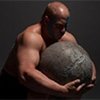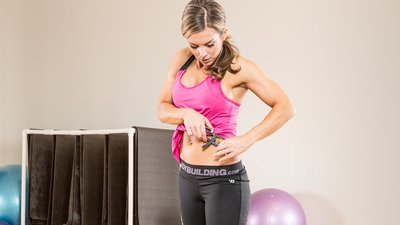A body fat measurement can be useful for tracking your weight-loss progress because, unlike the scale, it tells you how much of your weight is fat and how much is muscle and other good stuff. Here's how body fat is measured and what that number actually means.
Why Measure Your Body Fat?
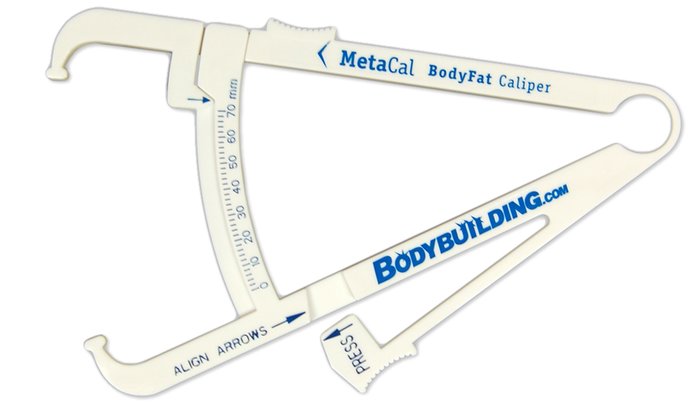
I recently measured a woman's body fat because she didn't like the number her personal trainer had given her. Maybe you've been tempted to make a similar request. There isn't anything wrong with it, but it shows a misunderstanding about what a person's body fat percentage means and how it's measured. So let's clear it up.
A body fat test is an attempt to separate every pound of your body into one of two categories: your fat mass and everything else. What isn't fat mass is considered "lean body mass," which consists of your bones, muscles, hair, water, and miscellaneous stuff. So no, it's not just muscle!
This ratio can be deceiving in a number of ways. For instance, small, slender people who don't weigh much may actually have a greater percentage of body fat than larger, more muscular people who weigh more. That's just one reason why your weight on the scale or a set of measurements doesn't necessarily give a true picture of your health.
Measuring Body Fat
There are many different methods for measuring body fat, but some are more accurate than others. Hydrostatic weighing and other high-tech machines are expensive and almost impossible for a layperson to access. There are also hand-held devices and scales which measure body fat, but these are often inaccurate. For our purposes, the easiest and most accurate choice is the caliper method.
Using Body Fat Calipers
The caliper method—which you can learn to do yourself—measures skin folds and puts those measurements into a formula. The formula will then spit out an estimated body fat percentage. Those formulas can also determine your fat weight and lean mass weight.
Depending on the type of formula you use, you'll grab skin folds on various areas of your body. It can be terribly difficult to pinch yourself and read the caliper at the same time. That's why I recommend getting a qualified professional to do your body fat measurement. If you don't have a pro at your disposal, grab a friend and learn how to measure each other's body fat using this article as your guide.
For the general population, I recommend the Jackson and Pollock formula (yes, that's really its name). This formula can be utilized in three-site, four-site, and seven-site tests. For people who carry more body fat than most of the population, I prefer the four-site Durnin and Womersley system. For lean bodybuilders, I use the nine-site Parillo equation. Although you're by no means limited to using one of these formulas, they seem to work the best and are the most widely used.
Each of these formulas is built upon fairly complex mathematical equations which take the sum of the caliper measurements and apply them to a constant. Unless you're really into math, how the formulas work doesn't really matter. What's important to remember is consistency. Choose a test, choose a formula, and stick with it!
Why? If you use a different formula, you can, and usually will, get a different result. If you use a different caliper, you can get a different result. If you measure seven points instead of three but still use the same caliper and formula, you can get different results.
Your choice of formula or the quality of your calipers is much less important than getting consistent numbers. The data is valuable because it reflects a change in your progress, not because of the actual number. Whether your body fat is truly 8 percent or 10 percent doesn't actually matter at all. What matters is that you see progress.
The lesson: Don't focus too hard on the number; focus on the changes in the number. Once you can get a consistent reading, you have all the info you need to gauge your progress as you work to transform your body.
Your goal when you test your body fat isn't to get accurate measurements, it's to get consistent measurements. Take that to heart and you'll do fine.
The Jackson and Pollock Three-Site Formula
What you'll need to begin:
- Body fat measuring calipers
- Helper (recommended for men, required for women)
- Felt-tip pen and measuring tape (recommended)
- Pen and paper or computer to write down the numbers and perform some basic math
- BodySpace profile page to record and track your results
The Three-Site Method
These instructions will help you perform a three-site Jackson and Pollock skinfold test using any inexpensive body fat calipers.
You may scoff at using inexpensive plastic calipers rather than more expensive varieties you see trainers using in gyms, but you shouldn't. I have performed more than 15,000 body fat measurements using a wide range of methods and I can attest that these simple tools and the following method are consistent with more complicated seven-site and nine-site testing.
Why The Three-Site Method?
- It's the easiest method to reproduce in future tests—provided you use the same tool, technique, and helper each time you test.
- It's the hardest method to screw up.
- It's the most consistent method for the broadest portion of the population. Although, if you are either obese or very lean and muscular, consider a different method performed by a professional.
When taking a skinfold, the basic idea is to "pinch and pull." Attempt to separate the fat tissue from the surrounding tissue with a good pinch, then pull away from the body just slightly.
Once you feel like you have a good pinch, perform these steps:
- Place the calipers about 1 centimeter to the side of your fingers.
- Press on the serrated thumb pad next to the word "press" until the two arrows line up.
- Note the measurement on the little scale to the right of the arrows. The hashes are in increments of two. That means one mark lower than 20 is 18.
- Release the pinch and repeat all of these steps several times for all three sites. Take the average of your pinches and plug it into the calculator tool.
Where To Test
The sites used to determine body fat are usually identified by bony markings or body parts that are consistent between people, like a nipple or navel. This enables you to accurately find a specific point on the body no matter your overall body composition, and find the same point again on anyone else.
When you first start, I recommended that you use measuring tape to find the exact point you need, marking the spot with a felt-tip pen. As you become more practiced, you will be able to ditch the extra tools.
Body Fat Testing Sites For Men
1. Chest
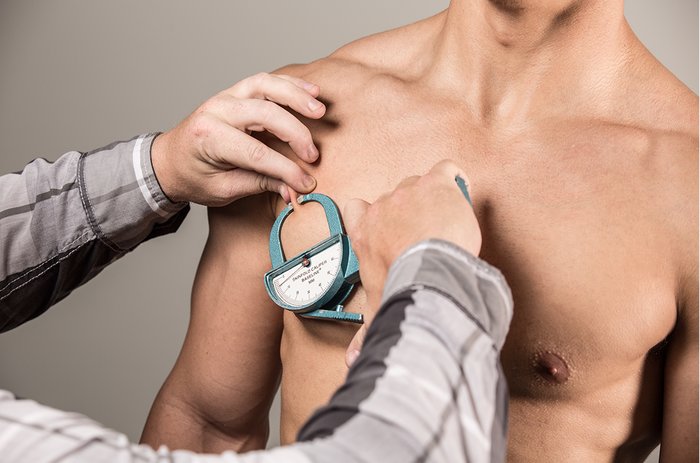
Imagine a vertical line running straight down through your right nipple. This reference point is called the "midaxillary line." Halfway between your nipple and the crease of the armpit is the point we're aiming for here. Pinch that spot diagonally, or have your helper do it.
2. Abdominal
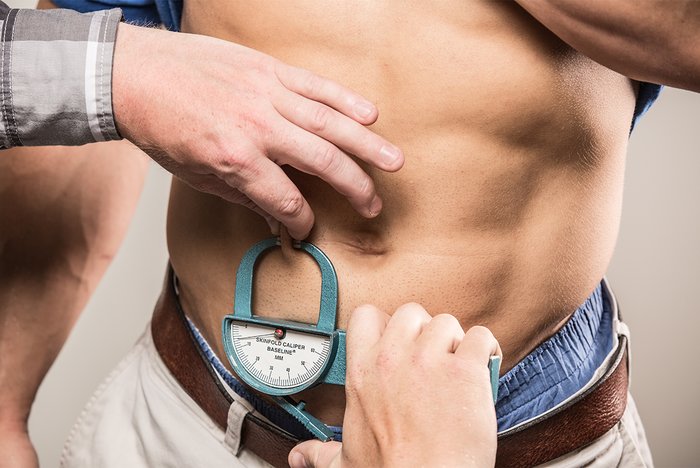
Make a vertical fold one inch to the right of your navel. If you have trouble getting a consistent vertical fold, it's OK to use a horizontal fold instead. There isn't much of a difference, but you should note if you do something different from normal and use that method in the future to stay consistent.
3. Thigh
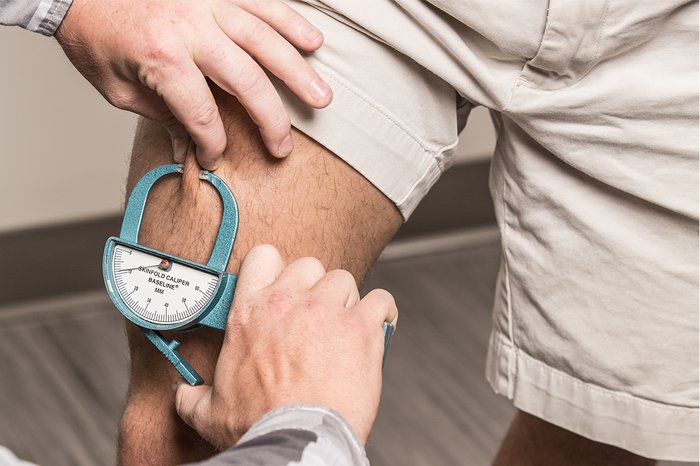
Find the midpoint between the hip and the knee and use a vertical fold. Unless you take out measuring tape and a marker for precise measuring, I recommend using your hand to measure rather than eyeballing it.
For instance, I use the distance between the tip of my thumb and pinky from the top of the knee, which for most people is fairly close to the midpoint. Since I do it that way every time, I'm able to be consistent.
Body Fat Testing Sites For Women
1. Triceps
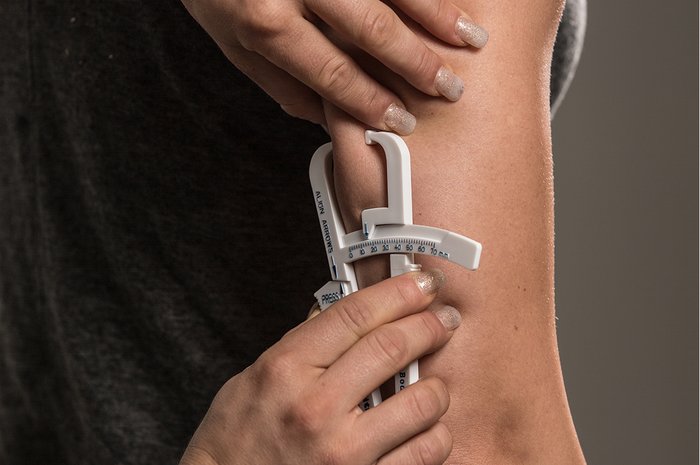
Find the midpoint between the acromion process (the bony knob on top of your shoulder) and the point of the elbow. You'll need a helper for this. Use a vertical fold.
2. Suprailiac
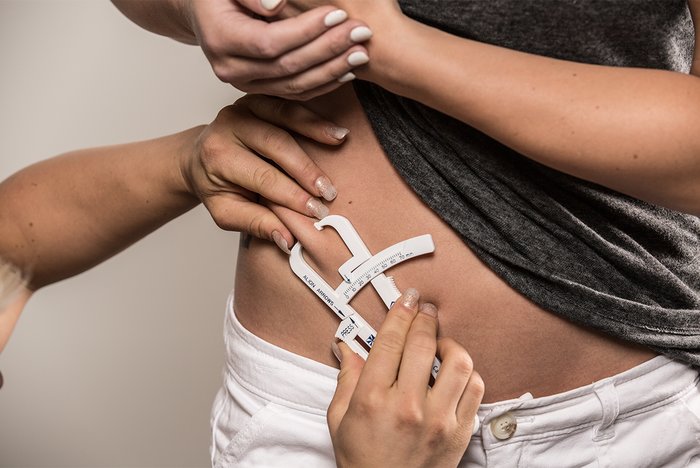
This site is found below the armpit at the top ridge of your hip bone, called the iliac crest or suprailiac, taken on the side. Gently press the area and find the ridge of the hip, going just above the bone. Measure using a diagonal fold.
3. Thigh
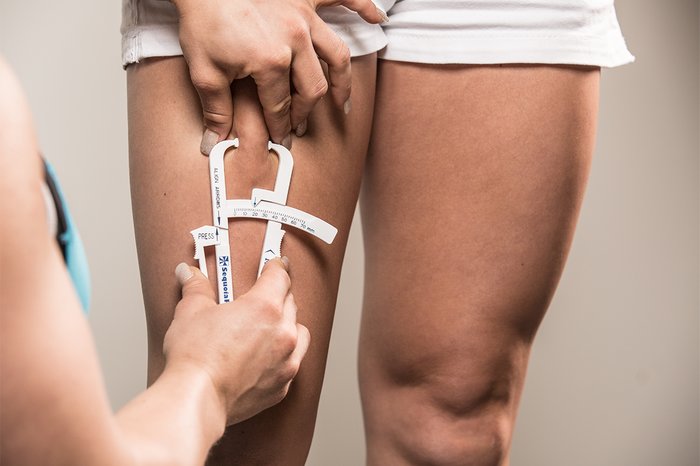
As with men, use the midpoint between the hip and the knee. As I mentioned, I normally use the distance between the tip of my thumb and pinky from the top of the knee, which is fairly close to the midpoint for most people. Measure using a vertical fold.
What's Next?
Enter your skinfold measurements into our Body Fat Calculator to get your results!
Why Does Body Fat Percentage Matter?
When people talk about wanting to lose weight, usually what they're really talking about is losing fat. Ideally, when you lose weight, you'll lose as much fat as possible, and as little lean mass as possible. It can actually be good for you to gain weight in the form of lean mass (muscle), since having more muscle actually helps you burn fat.[1]
So a more accurate and practical goal than just losing weight would be instead to lower your body fat percentage, also known as changing your body composition—the ratio of fat mass to lean mass that makes up your body.
When you lower your body fat percentage, you'll end up looking more fit, whether you got there by losing fat, gaining muscle, or a combination of both.
Using What's Useful
What constitutes a "healthy" level of body fat depends a lot on your sex and your goals. If you're not worried about keeping your body fat low for aesthetic or performance goals, then it's perfectly OK to have the goal of keeping your body fat percentage anywhere below "obese" and above "essential fat levels."
Women
- Obese: greater than 31 percent
- Acceptable: 25-31 percent
- Fit: 21-24 percent
- Athletic: 14-20 percent
- Essential fat levels: less than 13 percent
Men
- Obese: 25 percent
- Acceptable: 18-25 percent
- Fit: 14-17 percent
- Athletic: 6-13 percent
- Essential fat levels: less than 2-5 percent
Fat mass: Weight times body fat percentage
Lean mass: Weight minus fat mass
Use that number to gauge progress, because the scale doesn't always tell the whole story. You might be losing weight or gaining weight, but where is that weight coming from? Muscle or fat?
From a planning perspective, having your body fat percentage measured can help you determine realistic goals. Knowing your ratio of fat mass to lean mass will make it easier to determine how many pounds of fat you can likely lose each week. For instance, if you have a goal to lose 15 pounds in three months, knowing what percentage of your body composition is actually fat can help you decide whether that goal is reasonable.
Changes in your fat and lean mass weight can also allow you to make smart decisions about your programming. For example, if you lose lean mass, it means your nutrition probably needs a second look or that you may be training way too much.
Keep Your Eye On the Big Picture
For most people, the ultimate goal is to have a better looking, healthier body, so don't become obsessed with this or any other measurement. It's OK to use it, if only to put a number to the cosmetic changes you see in the mirror or track the effectiveness of your nutrition and training.
But consider making attainable progress goals, too, like getting through a training program without skipping workouts, or eating a vegetable every day.
These are easier to control than outcome goals, like achieving a certain body fat percentage by a certain date, which rely not just on the work you put in but a whole host of biological processes that happen under the surface.
Achieving these other goals will help motivate you to stick with your program and make the process and your fitness lifestyle more satisfying.
Do you know what your body fat percentage doesn't measure? Your health, your value as a person, or your skills as an athlete. These can't be measured with any calipers. Simply use this technique to gain one more level of insight. It can be a great tool to have in your arsenal.
References
- Kelley, D. E. (2005). Skeletal muscle fat oxidation: timing and flexibility are everything. Journal of Clinical Investigation, 115(7), 1699.
